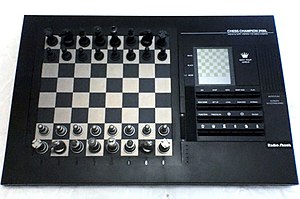 Image via Wikipedia
Image via WikipediaOf course, there's almost nothing "undisputed" about the previous sentence. The Kasparov/Deep Blue rivalry has its own chess subculture and sordid history, with some claiming it was a triumph in computing prowess, while others see it as a jury-rigged publicity stunt designed solely to boost IBM's stock price. The documentary film Game Over: Kasparov and the Machine is perhaps the most high-profile examination of this rivalry, though it is but one of many emotional and perhaps less-than-objective accounts of the events.
What makes this issue so contentious is that chess is perhaps the ideal human vs. machine intelligence contest. Chess is so mathematically complex it cannot (as yet) be rendered a solved game, which is a term for any game which has a methodical, reproducible strategy for achieving at worst a draw every time it is correctly used. Put more simply, there are so many possible moves in any game of chess that not even the most powerful supercomputer on Earth could efficiently model them all. Thus, computers -- like humans -- can only anticipate a limited number of moves in advance and must develop an ever-shifting strategy to defeat a capable opponent. You must think on the fly to win at chess.
Today, it is generally conceded that even consumer-grade computer hardware can model enough moves in advance of any given chess position to consistently outplay all but the most skilled human chessmasters. Even under tournament conditions where human players are given access to the computer's opening book -- the equivalent of watching game film on a human opponent to note tendencies and styles -- chess programs can now brute-force their way past most human players.
This is quite a stretch removed from the first computer ever to defeat a human opponent at chess, when the machine needed to significantly modify the game and the conditions of the contest to win.
What computer was the first to defeat a human opponent at chess?
MANIAC I defeated an anonymous, volunteer chess opponent all the way back in 1956. In a lot of ways this "victory" was a reverse Kirk-Kobayashi Maru, wherein the computer had to change the conditions of the test in order to defeat the human.
First, the still-unknown opponent who lost to MANIAC I was a novice player who learned the rules of chess only a week before. Anyone who has ever sat through little league baseball tryouts knows what sort of skill level to expect from a novice player of any game. This volunteer opponent likely wasn't an idiot, because he was an employee of Los Alamos National Laboratory. Despite an inexplicable propensity to lose laptop computers with nuclear secrets stored on them, Los Alamos employees tend to skew towards the smart end of the bell curve. Nonetheless, a smart rookie is still a rookie, even if he works at the birthplace of the atomic bomb. This brings us to our second point.
MANIAC I didn't defeat a human at conventional chess, it defeated a human at Los Alamos chess. See, MANIAC I couldn't handle an orthodox game of chess, so its programmers created a dumbed-down variant that's played on a six-by-six board with no bishops and two fewer pawns per side. Los Alamos chess also does not allow for castling or en passant capture. Basically, this is chess with training wheels-- and this was the chess variant that MANIAC I played to beat the rookie opponent.
Now, before you argue that MANIAC I might have been able to beat an experienced chess player if given the chance, let me point out that MANIAC I's historic victory was the third chess game the computer ever played. The second of MANIAC I's chess games was played against an experienced human opponent. The human won that match up, despite playing without his queen. Not exactly a ringing endorsement of the computer's chess insight.
MANIAC I's first chess game was played against itself, and thus it both won and lost.
These three games were the only chess contests MANIAC I ever played, likely because Los Alamos had better things to do with its rare-for-the-1950s computer than beat up on novice boardgamers. Also, as MANIAC I was a custom-built computer, no copies of the chess program were shared or preserved for the benefit of other computer labs. Thus, MANIAC I's "victory" over a human opponent remains a mere footnote chess computing history, but a welcome addition to the ranks of the Truly Trivial.
